Ultimate Guide to Exercises for Lumbar Herniated Disc Relief 2
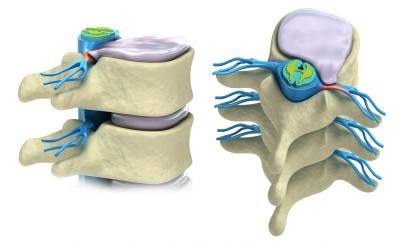
Did you find our previous article, “Disc Herniation Part 1,” helpful but are still battling discomfort? Are you eager to discover exercises that can effectively reposition your herniated disc and enhance your well-being? You’re in the right place.
In this comprehensive guide, we’ll cover:
- Effective Exercises for Repositioning a Herniated Disc: Learn the top movements to gently coax your disc back into alignment, reducing pain and improving mobility.
- Stabilization Techniques to Prevent Disc Displacement: Discover exercises that strengthen your core and back, ensuring your discs stay in place.
Understanding Lumbar Disc Herniation:
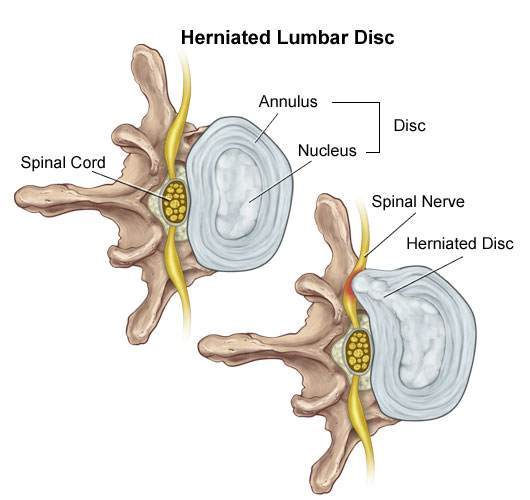
A herniated disc occurs when the disc’s nucleus breaks through the annulus, as shown in the illustration from neurosciences.beaumont.edu. But what triggers this displacement? The primary culprit is forward bending, which compresses the disc (think of it as a jelly-filled doughnut) and can lead to the annulus fracturing, allowing the nucleus to protrude and press against nerves.
Why Does it Hurt?
The disc’s exterior is tough cartilage, while its interior is softer, akin to mucus. Applying pressure on one side forces the inner material to the opposite side, similar to squeezing a doughnut. When a herniated disc or inflammation puts pressure on a nerve, pain ensues. The key to relief is applying counterpressure to reposition the disc.
For a deeper dive into herniated discs, refer to “Disc Herniation Part 1: Best Self-Treatments for Lumbar Disc Herniation.“
How to Apply Counterpressure:
The strategy involves bending your spine backwards or into the extension to shift the disc away from the nerve.
Exercises to Reposition a Herniated Disc: Note of Caution:
Initially, these exercises might intensify your pain slightly. If pain significantly worsens or radiates further down your leg during these exercises, cease immediately and consult a professional.
Exercises for Lumbar Herniated Disc
#1 Prone Lying Lumbar Herniated Disc
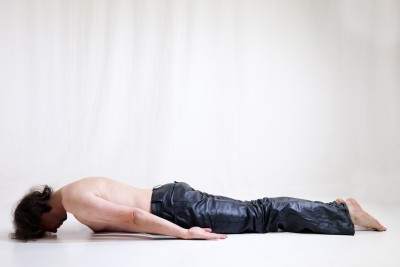
- Lie face down or prone in bed with your elbows tucked in under your side:
- As soon as you get up in the morning you should lie prone (face down). By getting in this position, your lower back becomes more arched, or as doctors say, you increase your lordosis.
- The increased lordosis pushes on the back of the disc helping to bring the nucleus forward into the correct position.
#2 Sphinx pose in Yoga For Lumbar Herniated Disc
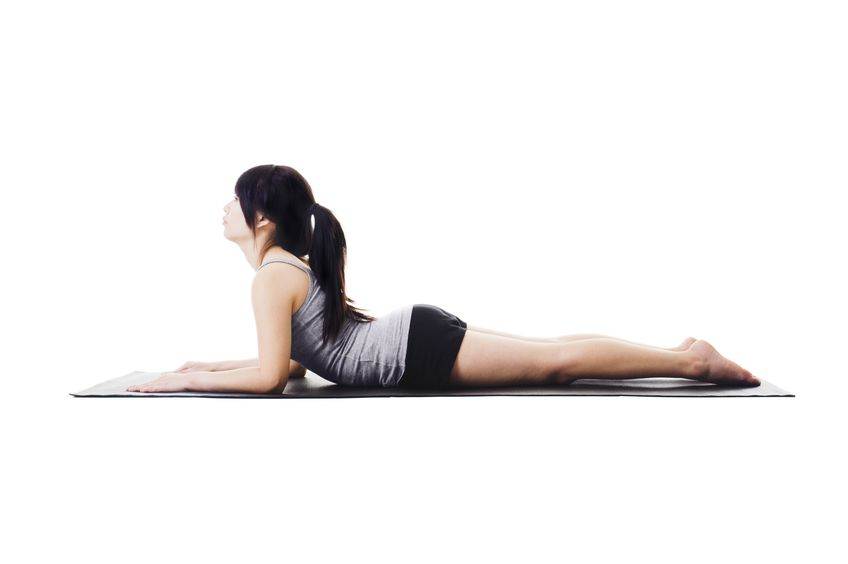
- Get into the prone position lying down on your stomach.
- Next, get on your elbows. If you have a hard time with this position go back into the prone lying position.
- Do these exercises hold each time for 1-2 seconds 6-8 times per set? This exercise can be repeated every two hours throughout the day.
Asses yourself. If the pain has decreased or the pain has moved away from the leg or thigh and into the hip or buttock, this is an improvement. Even if the pain is increased in the back but relieved in the leg this is an improvement and a green light that you should continue this exercise. You also get a green light if there is no difference at all.
- If your self-assessment gives you the green light, move on to the Cobra exercises just below.
- If your thigh or leg pain is worse, then stop right away.
- If your lower back, thighs and legs are the same you get a green light, so move on to the Cobra exercises.
#3 Cobras For Lumbar Herniated Disc
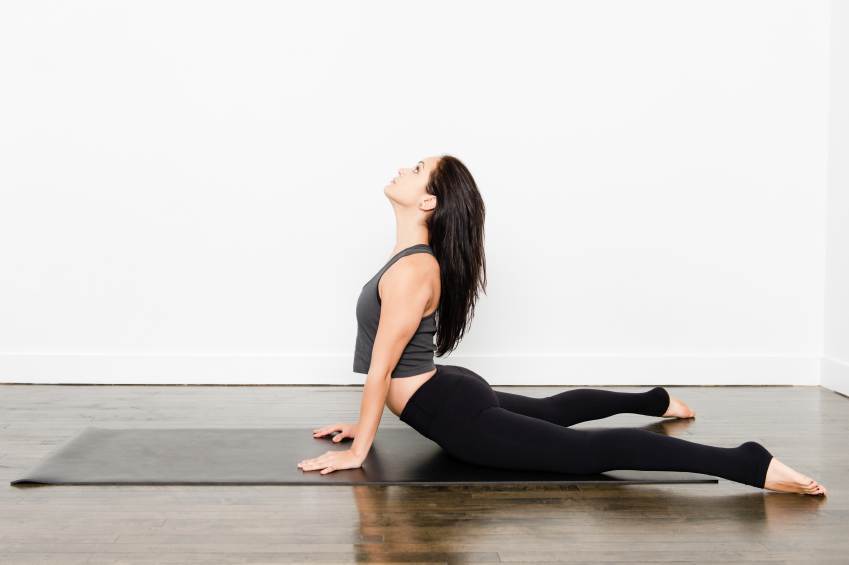
- Lie down face down with your hands underneath your shoulders.
- Push up from as high as you can until your lower back stops you or your elbows are straight.
- The pelvis should still be on the floor and the lower back muscles relaxed.
- Do these exercises hold each time for 1-2 seconds 6-8 times per set? This exercise can be repeated every two hours throughout the day.
Asses yourself. If the pain has decreased or the pain has moved away from the leg or thigh and into the hip or buttock, this is an improvement. Even if the pain is increased in the back but relieved in the leg this is an improvement and a green light that you should continue this exercise. If your thigh or leg pain is worse, then stop right away.
#4 Standing Extensions Lumbar Herniated Disc
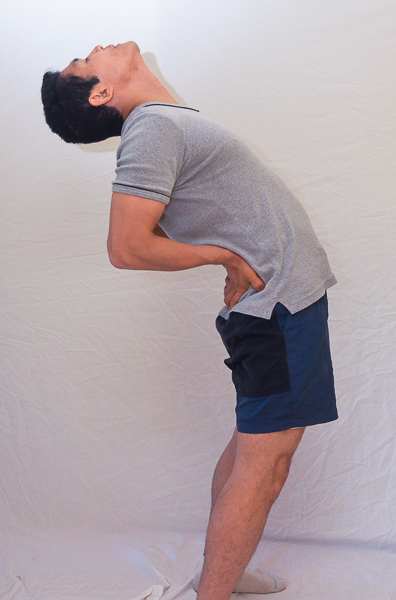
- Stand straight and put your hands behind your hips with your fingers facing down.
- Push your hands into your pelvis so that your lower back arches.
- Don’t use your lower back muscles
- These exercises can be done 6-8 times for 1-2 seconds. This exercise can be repeated every two hours throughout the day.
Stabilization Exercises: Prevent Your Disc From Coming Out By Having A Stable Spine.
#1 Cat-Camel or Cat-Camel For Herniated Disc
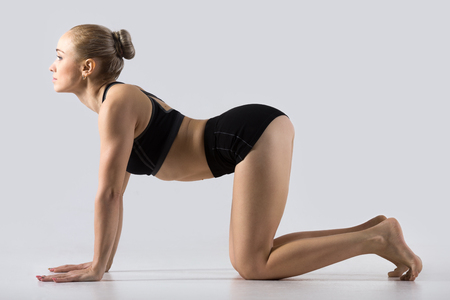
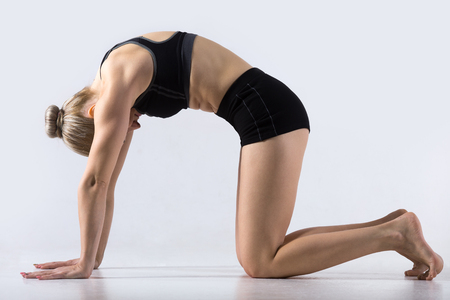
- On all fours with your knees under your hips and hands under your shoulders.
- Inhale and let your belly fall downwards toward the floor as you look up toward the ceiling for 2 seconds.
- Exhale and arch your back up as far as it will go or until you feel pain. You should not feel pain with this exercise, otherwise you are going too high.
- At the same time bend your neck forward and look toward your navel.
#2 Curl-Ups
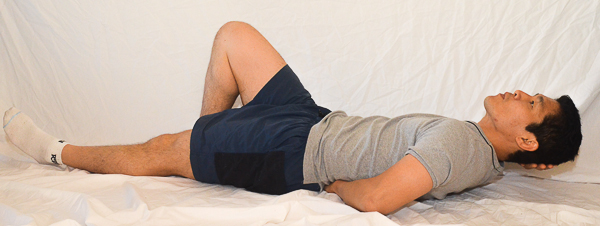
- To start, one foot is bent and the other is straight.
- One forearm goes under the arch of your lower back to support it.
- The other arm is supporting your head.
- Your head and neck come up as one block until your shoulder blades clear the floor.
- Do three sets of 5 working your way up to 10. If it’s easy, then hold for a couple of breaths.
#3 Squats
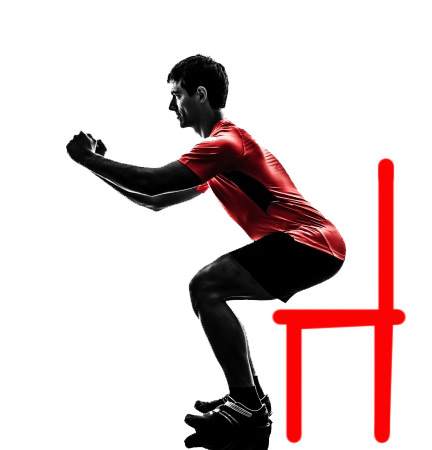
- Stand in front of a chair as if you are going to sit on it.
- Stand with your feet facing slightly more outward than your knee.
- Make sure your butt comes out, and keep lowering your butt until you touch the chair.
- Practice 3 sets of 10.
#4 Bird Dog
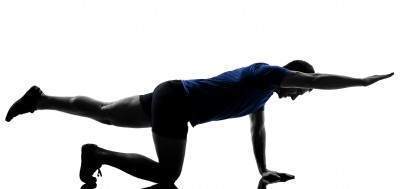
- Get into a crawling position with your hands and feet shoulder-width apart.
- Harden your core by contracting your abs and lower back. This is called bracing.
- Lift your arm first. If this is easy, then lift your leg only. If that is easy, then lift the opposite legs and arms, for example, right leg, and left arm.
- Want to make it tougher? Try lifting an arm and leg on the same side.
- 3 sets of 10. If you are shaking a little or cannot balance quite right, you’re doing the right exercise for you, i.e. lifting just the leg or arm might be easy, but lifting opposite arms and legs might put you off-balance a bit. Make sure you are stable before going to the advanced bird dog.
Tell us what you think in the comments below and like us on Facebook. This Toronto Downtown Chiropractor will answer all questions in the comments section. Let us know your vote for the best Toronto chiropractor in the comments section.
References
1. J Med Genet 2002;39:387-390 doi:10.1136/jmg.39.6.387
Related Categories: Disc Herniation, Elbow, Hip, Low Back Pain, Shoulder

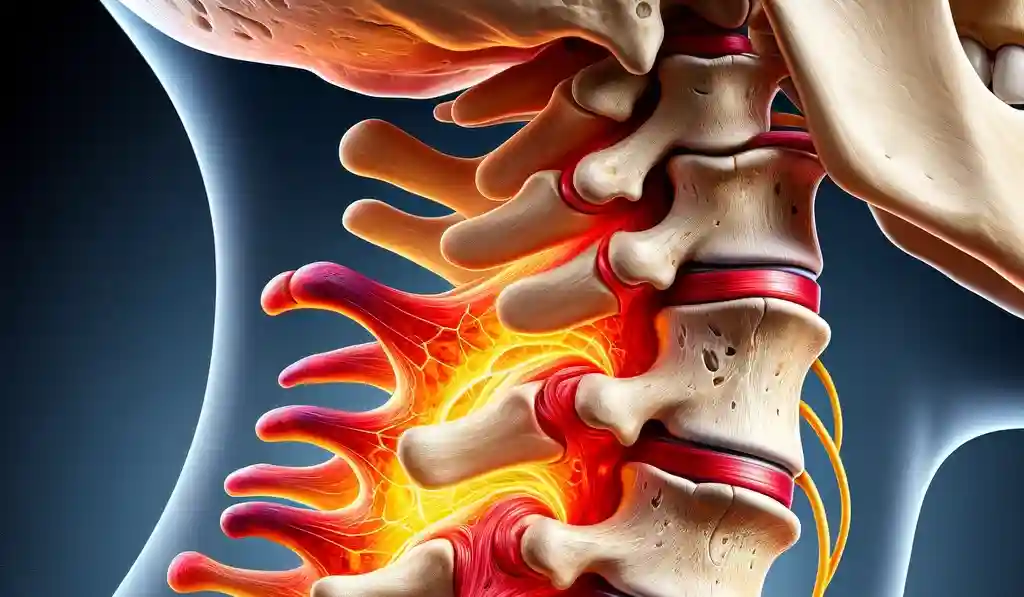
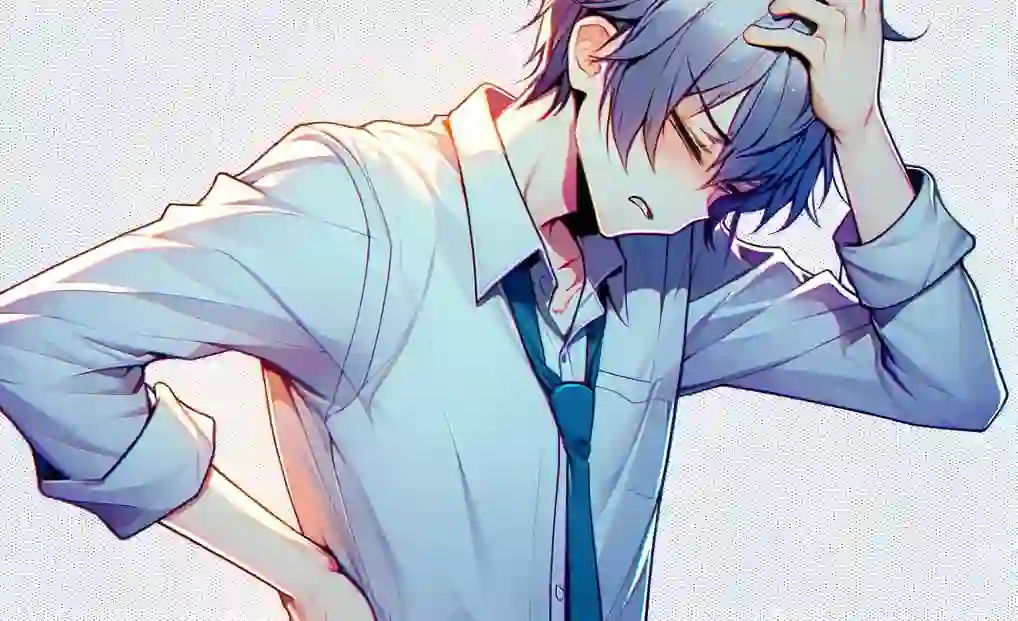
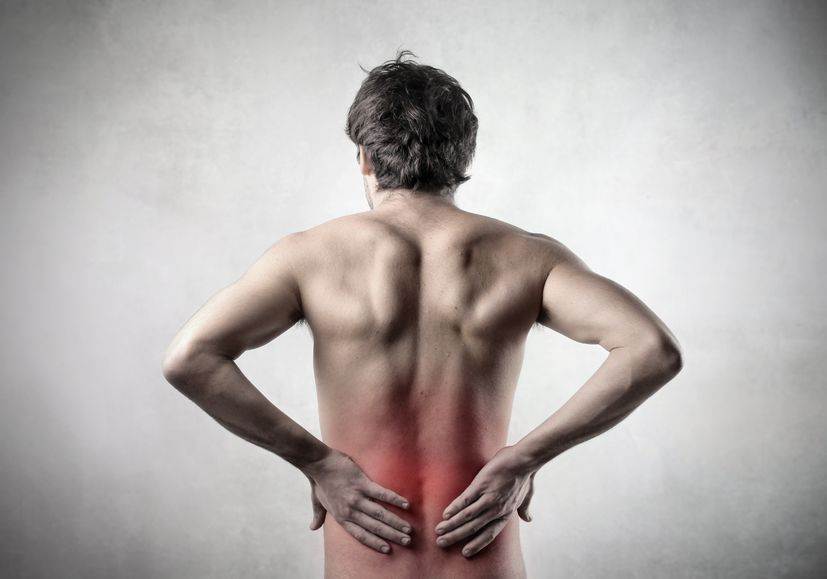
I have l5-s1disc extrusion that I found in Nov 2022. I have been doing physical therapy exercises and decompression therapy with the chiropractor. My symptoms has been less but I recently had an mri done and it’s show little bit more larger disc extrusions. I don’t know what am I doing wrong . I work in healthcare field so I have to move patient. Plz help me with this . Thank you
Author
Thanks for your question Dhurti. You don’t say if you went back to work or not causing the larger disc extrusion. If you went back to work and lifted patients then that is troubling. The other scenario is that you are getting the right treatment but the disc continues to get worse anyways. Such contributing factors are you sitting at home with a flexed “bad” posture causing your disc to come out further. You might also not be walking very much which would help most kinds of back problems. The idea is to always change position and don’t sit for extended periods of time in any one position. You should stand up at least once per hour. Your disc won’t like the extended periods of sitting or standing.
Hope that helps your L5-S1 disc extrusion. I do my best to answer your questions. If your have any more questions for this downtown Toronto chiropractor, please let me know.
Hi. I have two concurrent problems:
1. A bulging disc between L2and L3. It bulges to the left.
2. Facet syndrome
I’ve seen two chiropractors, had an MRI, PT with the MacKensize method and several cortisone injections.
Exercises for the bulging disc say to bend backwards but exercises for the facet syndrome say to curl the spine in the opposite direction. As these contradict each other, I don’t know which movements I should follow. I’ve had this pain for a year. Any help would be appreciated.
L4-L5 protrusion, I had sciatica pain while sitting 5 years ago and then with your exercises I had no problems. A year back I started playing soccer and after 8 months there Sciatica is back and worse. If I stand for more than 15 minutes the right leg hurts badly, even the same with walking. Surprisingly the pain eases when I sit.
This is going on from there months, will this pain ever go out it’s permanent??
Please help as it’s very depressing. I would need your suggestions.
Thank you in advance
Author
Thanks for your question Ferdinand. I assume you have already done the exercises here in this article as you were doing them previously. The fact that sitting was painful and not anymore means that the nature of the problem has changed. The disc has either changed direction as you are doing a different activity or it is a different problem. It’s best to get a local opinion from a chiropractor to determine if that is the case. In that case, some of the same exercises can be used with the exception of the extension exercises. However I cannot tell without examining you.
Hope that helps. The above is an opinion and not a recommendation. If you have any more questions I will do my best to give you a good answer.
Hi dr Ken
Just wanted to say I have tingling down the leg , paun in hip, and pain in my hamstring when sitting. I found relief from lying on my stomach and pointing my toes out as far as they can go. Nothing else helped very much so far. My pain goes away when I lien on my stomach . Any advice what’s wrong what to do? Thanks!
Author
Thanks for your question Dan. Have you tried these exercises especially the exercises here but also in part 1. https://www.bodiempowerment.com/disc-herniation-part-1/
That is my opinion and not a recommendation. Always see a chiropractor that can examine you and not just rely on the internet. I will do my best to answer your questions regarding herniated discs, chiropractic, rehabilitation and exercises to get you feeling better.
Hope that helps.
Hi. I have had weird neuro symptoms for three months. Feet tingling. , muscle spasms in my legs and had episode where legs didn’t want to move. I have been dc with buldging t 7 t8. I have been a runner since I was 23. I am 58 and still running. Would you suggest I stop running ? What weight lifting is safe for me ? Is it ok to do lower body. What should I not do with my upper body ? Thank you
Author
Thanks for your comment, Robin. Various diagnosis is possible like large disc herniation in your mid-back or you may have an additional herniation in your lower back or a trapped nerve in your leg. Circulatory problems are also possible. It’s not likely you have stenosis as you are too young. Until your spasms and tingling are better I would suggest staying away from squats, deadlifts and most abdominal exercises except for planks, side planks and leg lifts while standing (standing ab exercise machine). You can do most upper body weight lifting but keep it light. I would stay away from compressive exercises that puts weights above your head like a shoulder press / Military press.
It is better to seek out the opinion of a person that has examined you. I am going on limited information.
Hope that helps. The above is an opinion and not a recommendation. I will do best my to give you a decent opinion.
Sir my MRI illustrated that i have disc bulge in l4-l5 and l5-s1 levels on right side but i feel no pain in bending forward but sometimes there is a sensitive pain on right side of my lower back.its not getting worse but its not healing either what should i do?
Author
Thanks for your question Abhishek. You should always seek out the opinion of someone that can examine you and take a proper history. Why don’t you try the exercises here in this article? Just make sure that it is Ok with your chiropractor or physiotherapist or medical doctor.
That is my opinion and not a recommendation. Hope that helps.
Last October 2018 I diagnose a Lumbar radiocuphalty as per my MRI result.i have L3, L4 & L5 and I advice to undergo rehab for theraphy.hence I notice that little nothing happen I stopped it and I do exercise as what during my rehab do.but what can you suggest as best exercise for this kind of back pain.I hope you for your answer DR.Thank you and God bless.
Author
Thanks for your question Helen. You say you have L3, L4, and L5. Since everybody has those in their body with very few exceptions I am assuming that you are referring to a disc herniation at those levels. You are not getting better with the rehab exercises that you were given. It is possible that you would benefit from the exercises in this article for disc herniation. Keep in mind I can’t take your history or do a proper examination. You could try the exercises in this article but make sure they are approved by your current health care practitioner.
Hope that helps your herniated disc.
Hello dr. Ken
L5-S1
Before 1 year and 3 month I started feeling tingling and numbness,
after some months i did the MRI and it shows that i have a PROLAPSE disc herniation , I started doing these exercises that are recommended two weeks ago, and i feel so much better.
But when I wake up i feel pain almost down all my leg.
Do you have any suggestion and how much it longs to heal this…
Author
Thanks for your question Steve. It’s normal to feel more pain in the morning as you have a larger disc from the disc expanding like a sponge does when there is no pressure on it. If you bring your head back and breath out you while doing the cobra exercises that might help you further. Hope that helps your herniated disc. The above is an opinion and not a recommendation.
My goal is to help anyone that needs it whether here in downtown Toronto or anywhere else and be the best chiropractor that I can be.
Thanks for your answer Dr Ken. I also have few questions , is it good to do leg streches and hanging and how many steps is it suggest to walk per day ..
Thank you again !!
Hi Dr. Ken,
I’ve got a herniated disc between L4 & L5 for 7 months. It’s because I did a standing kick back exercise on my left leg, and I had a PT about 2 months but it didn’t make the pain away. My PT wanted me to do the cobra position but it hurt so much. Does this position make the pain worse? Which exercise should I do in my case?
Thank you in advance!
Author
Thanks for your question Didi. I would try to do some flexion exercises like flexion in lying (knee to chest exercise) repeatedly 10X while holding the for about 1 sec. This could help. I give you this opinion based on the way you hurt yourself and the fact that the extension was too painful.
The above is an opinion and not a recommendation.
Hope that helps your herniated disc.
Dr Ken…this is a follow up to my previous post. I can do the full Cobra for 5 to 10 seconds with no pain, however, after doing it for a couple of days, I have noticed some increased pain in my low back. In the self assessment it says that increased LBP is OK as long as there is no added pain to the leg/thigh. What is causing this increased pain and why is it acceptable? Also, I realize that everyones condition is unique, but what is the average length of time that it takes for these exercises to provide relief/resolution from herniated disc symptoms? Thanks again!
Author
Jim, yes absolutely, it is Ok to have more back pain if there are no increased symptoms in the thigh, leg, foot. It’s called centralization which is the body taking more pressure off the nerve so you start feeling the pain where the pain came from. The more pressure on the nerve the further the pain will go. With an extrusion, it can take 6 months even a year depending on the severity. Since you can do the extension and you are centralizing you will probably take less than 6 months with treatment. With no treatment, you will likely take longer. The above is an opinion and not a recommendation like my previous post.
Hope that helps your herniated disc or disc extrusion.
Dr i am having loss of lumbar lordosis.i am undergoing physiotherapy it has subsided my pain .two days back i did standing backward strech but now i feel pain on my effected area.so m little worried.and can i do forward bending once my pain is gone
Author
Thanks for your question Saif. “Standing backwards stretches” are not the same as the “lying extensions” that I have shown you in this article. They put the pressure on the lower back in a different way, slightly different place and often has different effects. People often get worse especially at the beginning compared to “extension in lying” or the Cobra. I name it the Cobra as it is similar but the extension is done very different from the Yoga way of doing the Cobra. You have to relax the lower back whereas with the Yoga way you need to keep your lower back and pelvis up. Big difference.
Hope that helps your herniated disc. The above is an opinion and not a recommendation. If you have any more questions for this downtown Toronto chiropractor I will do my best to give you great information.
Thanku for telling me this doctor.my pain is much better now.infact in normal conditions like walking sleeping sitting sometimes unconsciously i bend i dont feel much pain.my X-Ray report shows my spine has become flat so how long will it take to get my spines curve back.as i am an actor so many times physical activities are involved.so i am little worried wheathr ill get my normal routine or not because i also love doing my house cleaning toilet cleaning.is this injury permanent doctor.please suggest me regarding this
Author
Thanks for your question Saif. You are asking how long will it take for the curve to come back to your lower back. It’s important to the fix the person and not the X-ray Saif. So sitting with great posture and doing your exercises here in this article or any other exercises that your health practitioner may have recommended. Keep in mind that I have not examined you so other exercises may be more important.
The cobra exercises, in particular, is the key to helping you decrease pain and increasing function. Don’t pay too much attention to what the X-rays say. That’s my opinion and not a recommendation.
Hope that helps your herniated disc.
Hello Dr Ken…thank you so much for the valuable information! I was diagnosed with a herniated disc at L4, 4 to 7 mm, per MRI. I understand the theory behind your exercises to ‘push’ a bulge back in place, however, if nucleus fluid has leaked out of the disc, what is going to help that? Will my body break down the fluid over time? Slowly decreasing the pressure on the nerve? Does the tear in the annulus eventually hear and thereby not letting additional nucleus fluid escape?
Author
Thanks for your question Jim. IT depends if the problem is a disc, protrusion or extrusion. At 7mm most times the nucleus has gone beyond the annulus but not always. I treat at least one person a month with an extrusion and I can say that most of them respond. Sometimes it is not direct extension it might be another direction but there is usually a direction of exercise that helps. Sometimes it is not clear but that is the job your chiropractor or physiotherapist to determine. The extrusion does usually get broken down by the body. If you can see a before or after MRI most times what happens is that the symptoms are usually significantly decreased along but with only a small decrease in the extrusion. There are cases where surgery is the only option though.
Does the tear in the annulus eventually hear and thereby not letting additional nucleus fluid escape? Not much healing in the annulus. Usually you are better but not cured after 6 months without any treatment but obviously better with treatment.
Hello Dr. Nakamura,
My MRI shows that I have L5S1 disc degeneration, the space between the vertebras is very narrow and black, and also the disc is paracentrally herniated pushing into the spinal canal. I get a lot of pain in the buttocks, lower back and around the gluteus medius are, sometimes a little in the outer thighs. My chiropractor seems to think that in my case back bends would not be good, I assume because the bulge is too large to be pushed back into the almost non-existence space (?). What kind of exercises would you recommend? Thank you so much for your help.
Author
Thanks for your question Andrea. First keep in mind that I haven’t examined you, so I am going by the little bit of information that you have given me regarding your symptoms and your MRI. That opinion may change given new information. Your symptoms and MRI seem typical of posterolateral disc herniations that is the most common. They typically get better with the exercises in this article especially emphasizing the extensions. If you are getting better I would suggest that you continue on with your chiropractic treatments and exercises.
If you aren’t getting better or have plateaued more than a couple weeks you may want to give the exercises a try. Like any exercise, they can make you worse.
Hope that helps your herniated disc.
Hi Doctor,
I am 40 and have had lower back pain for 5+ years. I have been diagnosed with L4-L5 central disc herniation with right paracentral annular tear indenting the anterior thecal sac contributing to mild-to-moderate central canal stenosis. L5-S1, central disc herniation indenting the anterior epidural space.
Mainly this bothers me during sleep. I cannot sleep on my stomach or either side. I can sleep on my back with a pillow under my knees and in a not-too-hard mattress. I am wondering if the exercises may help me get back to sleep on my side.
Thanks for writing this,
Javier
Author
Thanks for your question Javier. You should try the exercises I have here on this article. As with any exercises you can get worse. It is always better to check with a professional that can check you personally.
Hope that helps your herniated disc.
I have been diagnosed with a large farlateral disc herniation at L3 by imaging and clinical presentation. I have sensory and motor deficits in my left leg. I haven’t seen a surgeon yet as I am trying to treat conservatively. I understand the flexibility exercises are best for me NOT extension. Any suggestions.
Thanks!
Author
Thanks for your question Sue. The most likely scenario is that exercises going to the side will be helpful. However, I have seen many cases where people respond when they flex and others that respond when they extend when there is a “far Lateral” disc herniation. So the only real way to tell is by actually trying the various types of exercises I just mentioned. However, a healthcare practitioner that can guide is most important as you will likely stop doing an exercise at the wrong time as it’s “sore or painful” Sometimes it is a good sign other times if the pain starts going down the leg then that is a bad sign. So get yourself a chiropractor or physiotherapist that knows what to do and take it from there.
Hope that helps your herniated disc. The above is an opinion and not a recommendation.